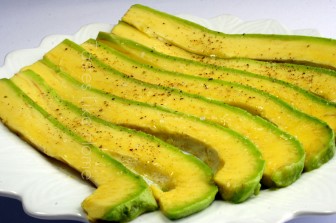Hi Everyone, Contrary to popular belief, avocados are NOT rich in cholesterol. Cholesterol is primarily derived from foods of animal sources.
Avocados are rich in the good type of fat – monounsaturated fat which is a type of unsaturated fat. While saturated and trans fats increase the risk for certain diseases, monounsaturated and poly-unsaturated fats, decrease such risks.
Butter pear, pear, avocado, zaboca has its origins in Central America but today, this fruit can be found the world over as long as the climate is tropical. There are many varieties of avocados and each variety varies in size, shape, and colour. Full of essential nutrients found in this singular source, someone once referred to the avocado as superman without the cape! And that someone was not off the mark.
Nutrients & Benefits
Vitamin C, Vitamin B6, Folate, Vitamin E and Vitamin K are among the many nutrients that an avocado provides. Vitamin C we need in order to make connective tissues that bind the body cells together, we also need it for the production of blood, the building of strong bones and teeth and to assist in the absorption of iron.

Vitamin E acts as an antioxidant and can help prevent heart disease, stroke and cancer.
Vitamin K’s main function relates of factors in the blood in order to enable it to clot properly in the event of injury. Avocado is a super fruit! Not only are avocados rich in vitamins but also in minerals, namely, magnesium, potassium and copper.
Due to its monounsaturated fat content, avocados are recommended as part of a healthy diet by medical practioners. They (avocados) are known to assist the body in absorbing the fat-soluble caro-tenoids – alpha and beta-carotene. Carotenoids are chemicals with nutritive properties that exist in the pigment that colours plants and animals. These carotenoids are important as antioxidants, as well as in their capacity to get converted to essential vitamins. When acting as antioxidants, carotenoids, are shown to reduce the damage caused by free radicals. Free radicals are organic molecules in our bodies that contribute to aging and tissue damage.

Ongoing studies have shown where the high folate-content of avocado can help prevent strokes. Due to this super fruit’s dense nutrient content, tests are being done to see how effective it can be in combating breast, prostate and oral cancer and the lowering of cholesterol. The truth is, for ages the avocado fruit and indeed its leaves have been used by many as folk medicine. Just the other day some friends were over at my house for lunch and before they left, they went to pick some of the leaves off the avocado tree in my yard. One of them swore by its ability to “cleanse” the inside. She recommended boiling four of the dried leaves with 3 cups of water, cool it, refrigerate and then drink a little each morning for seven straight days. I did. I am not sure if it worked but I felt good just doing it. I had made two sets of the concoction so I drank mine over a period of two weeks; what I can tell you, however, is that I noticed a marked decrease in the frequency of my migraines aura over that period, though I was exposed to some of my migraine triggers.
To date, I know many people that make pear-leaf tea and drink it, not just for the flavour it gives as a tealeaf but also for stomach cramps, purging and cleansing of the skin.
Buying Guide
There are many varieties of avocado but they fall into three main categories – the West Indian with the smooth leathery skin, the Guatemalan with a thick rough skin (think Hass) and the Mexican, smaller with a soft thin skin. Depending on the variety, some of the avocados when ripe will remain green and some will darken, turning purple. We get both varieties. The Mexican and Guatemalan when ripe, the flesh tends to be pale green but the flesh of the West Indian avocado turns cream to yellow, and without being prejudiced, I think it’s the creamiest of the lot.
Avocados do not ripen on the tree. They are picked when they are fully grown and then set to ripen. They can take 1 – 2 weeks to ripen. Often the vendor from who you purchase your avocado will tell you exactly when it will be ripe, however, if you purchased it in a supermarket, when you get home, place it in a paper bag and leave it at room temperature to ripen checking every other day. If you want the avocado to ripen faster, place an apple in the bag. A ripe avocado will yield to gentle pressure when pressed with a thumb.
Uses
The simplest way to eat an avocado is to cut it in half, remove the skin (which will come off easily as long as the fruit is ripe), slice and eat. You can opt to sprinkle a little salt like I do. It is a fruit that oxidizes (darkens when exposed to air), in order to prevent this, squeeze some lemon or lime juice over it. I once had guacamole where the hostess just added the seeds to the mixture instead of lemon juice and the avocados did not discolour.
Given that avocados are always way too much to eat at one go, it is advisable that you leave the seed in the remaining half, cover tightly with plastic wrap and refrigerate.
Avocados are used to make spreads, salads, dips, smoothies and shakes. Different cuisines use them in both savoury and sweet preparations.
The tree is my yard is blossoming and I can see tiny little bulbs that are going to grow into large, creamy, buttery pears and I can’t wait to have my first taste of avocado for the season.
Cynthia





